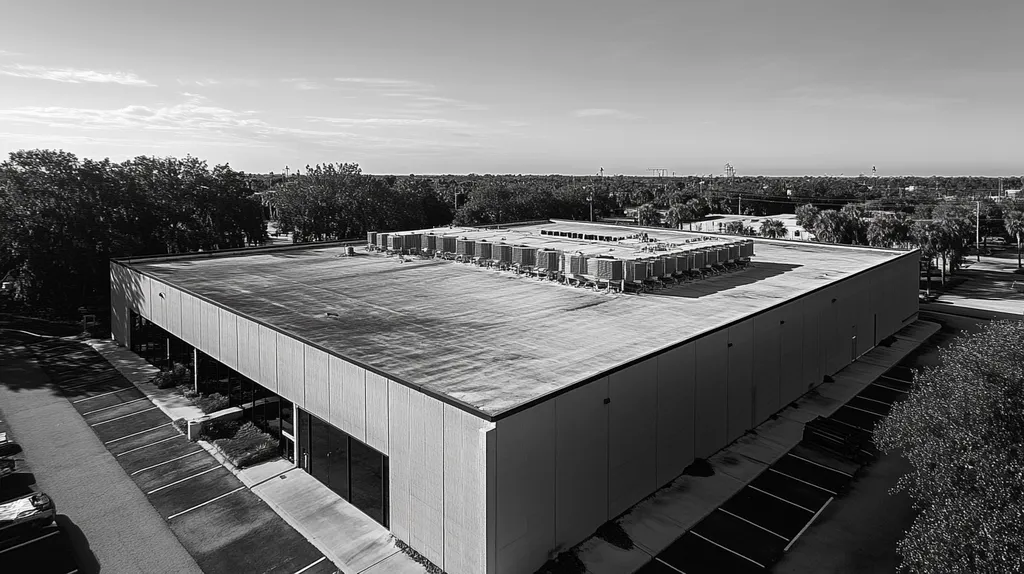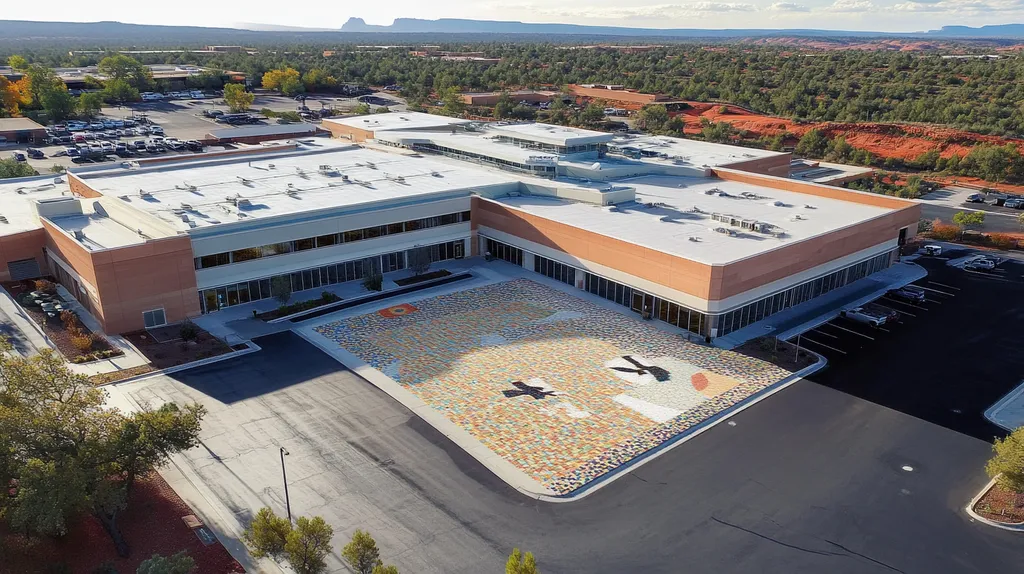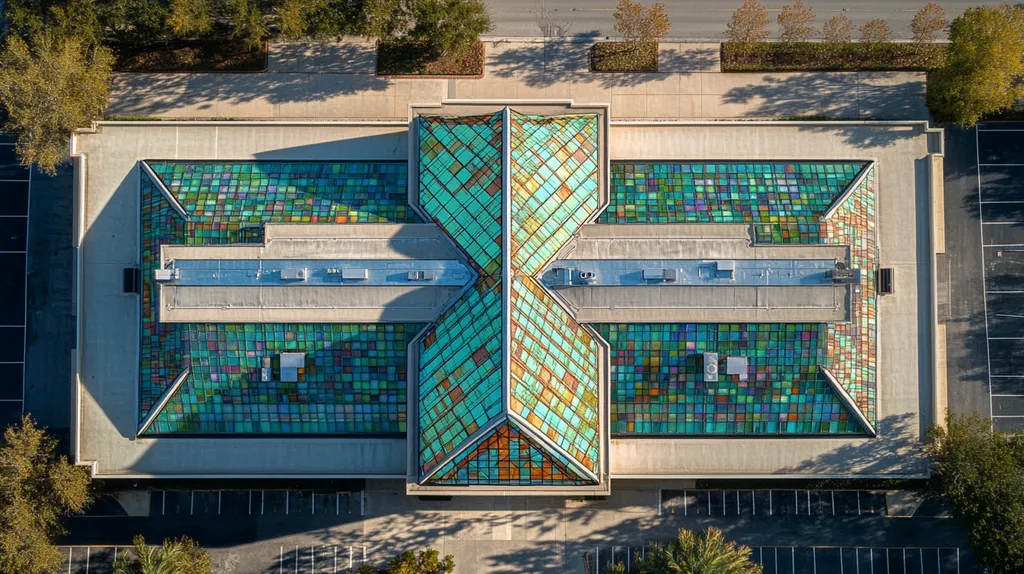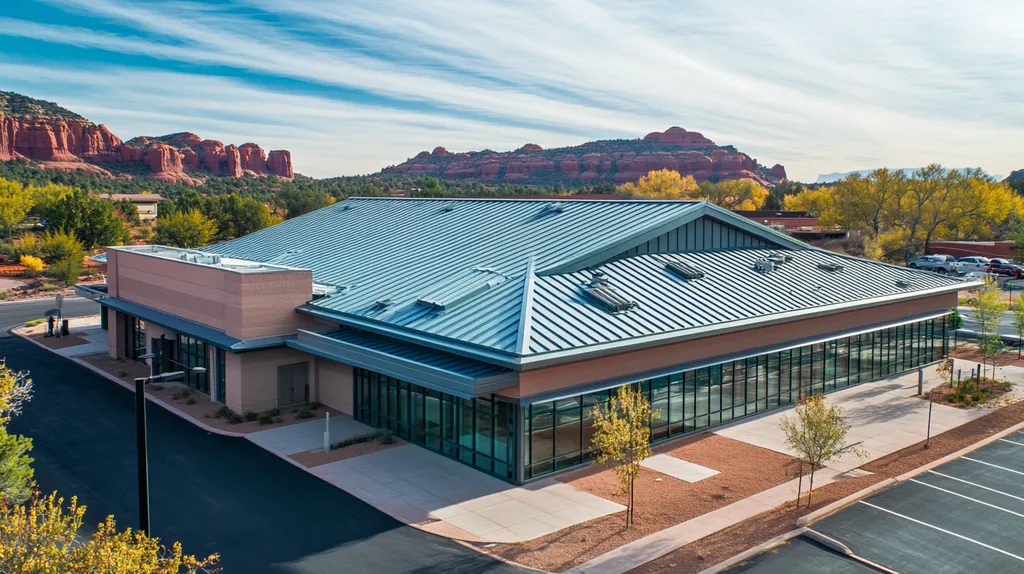Commercial roofing failures cost US businesses over $2 billion annually, with drainage-related issues accounting for 85% of premature system breakdowns. The relationship between roof coatings and drainage systems remains one of the most misunderstood aspects of commercial roof maintenance.
Despite advances in coating technology, fundamental misconceptions about how coatings interact with drainage systems continue to create costly problems for property owners and facility managers.
This analysis separates fact from fiction regarding coating applications and roof drainage, examining common myths, practical implications, and evidence-based solutions that protect commercial roofing investments.
SECTION 1: COMMON MISCONCEPTIONS
Commercial roofing decisions often hinge on misconceptions about protective coatings and their relationship with drainage systems. These misunderstandings can lead to compromised roof integrity, structural damage, and significant financial losses. When property owners and facility managers make decisions based on these false assumptions, they risk creating long-term problems that could have been avoided through proper understanding of how coatings and drainage systems work together.
Misconception A: Roof Coatings Eliminate the Need for Roof Drainage Systems
Though many believe flat roofs with protective coatings can function without dedicated drainage systems, this dangerous misconception overlooks fundamental architectural requirements. Every flat roof requires engineered positive drainage and properly designed drain systems to prevent water accumulation. (source: Waterproof Magazine)
Protective coatings serve to enhance waterproofing capabilities but cannot replace the critical function of drainage systems. Even the highest quality coating will eventually fail if subjected to constant ponding water, leading to premature roof deterioration.
Building codes and insurance requirements typically mandate specific drainage configurations. Attempting to bypass these requirements by relying solely on coatings can result in code violations and potentially void warranty coverage.
The most effective approach combines quality coatings with properly designed and maintained drainage systems. This integrated strategy provides multiple layers of protection against water damage.
Misconception B: Coatings Prevent All Forms of Ponding Water Damage
While protective coatings can enhance water resistance, they cannot completely prevent damage from standing water. Even specialized ponding-resistant coatings have limitations and will eventually break down under prolonged water exposure.
The weight of ponding water creates significant stress on roof structures. A single inch of standing water adds approximately 5.2 pounds per square foot of load, which can compromise structural integrity over time.
Environmental factors like freeze-thaw cycles and UV exposure accelerate coating degradation in areas of persistent ponding. These conditions can create weak points where water eventually penetrates the protective barrier.
Regular inspection and maintenance remain essential, as coatings can mask underlying drainage issues until significant damage occurs. Early detection of ponding problems helps prevent costly structural repairs.
Misconception C: Application of Coatings Always Improves Drainage Efficiency
The assumption that adding a coating layer automatically enhances drainage performance often leads to disappointed property owners. Coating applications require careful consideration of existing drainage patterns and roof slope to avoid creating new problem areas.
Improper coating application can actually worsen drainage issues by creating uneven surfaces or blocking existing drainage paths. Surface preparation and application technique directly impact how water flows across the roof.
Temperature fluctuations and building settlement can affect coating performance over time. What initially appears to be improved drainage may change as the coating ages and the building shifts.
Success requires detailed assessment of current drainage patterns before coating application. Professional evaluation helps ensure the coating system complements rather than compromises existing drainage design.
SECTION 2: PRACTICAL IMPLICATIONS
The relationship between roof coatings and drainage systems demands careful consideration, as even minor oversights can cascade into major structural issues. When coating decisions are made without understanding drainage implications, property owners risk creating vulnerabilities that compromise their entire roofing investment. A systematic approach to coating selection and application becomes essential for maintaining roof integrity and preventing water-related damage.
Impact of Coatings on Water Flow and Drainage Paths
The physical properties of roof coatings directly influence how water moves across the surface. Different coating formulations create varying degrees of surface tension and friction, which can either facilitate or impede water flow toward drainage points.
Surface profile changes from coating application can create unexpected water collection points. Even minimal variations in coating thickness can alter established drainage patterns, potentially directing water away from designed collection areas.
Acrylic reinforced and silicone roof coatings can significantly enhance water resistance when properly applied, providing superior protection against ponding water damage on flat and low-slope roofs. (source: Get Smart Seal)
Temperature fluctuations cause coatings to expand and contract, potentially creating new drainage patterns over time. Regular monitoring helps identify these changes before they lead to drainage problems.
Interaction Between Coatings and Roof Drain Performance
Roof drains require precise engineering to function effectively, and coating applications must respect these design parameters. Excessive coating thickness around drain areas can reduce drain capacity and create barriers to water flow.
The interface between coating materials and drain components demands special attention. Improper coating application near drains can compromise watertight seals and create entry points for moisture beneath the roof membrane.
Thermal movement between coated surfaces and drain assemblies can stress connection points. This stress may lead to separation and subsequent leaks if proper expansion allowances aren’t maintained.
Regular inspection of drain areas after coating application helps identify potential issues before they escalate. Particular attention should focus on coating adhesion and drain rim clearance.
Effects of Improper Coating Application on Roof Water Management
Application technique significantly impacts a coating’s ability to support proper drainage. Uneven application creates high and low spots that can trap water and prevent it from reaching designated drainage points.
Environmental conditions during application affect coating performance and durability. Temperature, humidity, and cure times must be carefully monitored to ensure optimal coating characteristics.
Membrane seams and transitions require special attention during coating application. These areas are particularly vulnerable to water infiltration if coating thickness varies or adhesion is compromised.
The long-term success of water management depends on proper surface preparation before coating application. Failing to address underlying surface irregularities can create persistent drainage problems that worsen over time.
SECTION 3: COST OF MISINFORMATION
The financial implications of misunderstanding coating and drainage relationships extend far beyond initial installation costs. When property owners make decisions based on incorrect assumptions about roof coatings, they often create cascading problems that multiply repair expenses. Industry data shows that drainage-related issues account for over 60% of premature roof failures, making this one of the most critical and costly areas of commercial roof management.
Financial Risks of Relying Solely on Coatings
Water collection can overload a roof’s weight capacity and lead to collapse if drains are clogged or poorly implemented, creating devastating financial consequences. Backup drains help mitigate water backup but cannot replace the need for comprehensive drainage solutions. (source: Waterproof Magazine)
Property owners often invest heavily in premium coating products while neglecting fundamental drainage requirements. This misallocation of resources creates a false sense of security while leaving the roof vulnerable to serious structural damage.
Insurance carriers frequently exclude coverage for damage resulting from inadequate drainage maintenance. This leaves building owners fully exposed to repair costs that could easily reach six figures for larger commercial properties.
The compounding effect of delayed maintenance and improper drainage solutions typically results in repair costs 3-5 times higher than necessary. These escalating expenses often force difficult decisions between emergency repairs and other critical facility needs.
Increased Maintenance and Repair Costs from Drainage Neglect
When drainage systems fail due to over-reliance on coatings, the resulting damage extends far beyond surface-level issues. Water infiltration can compromise structural elements, requiring extensive repairs to roofing components and interior building systems.
Emergency repair costs typically run 300-400% higher than planned maintenance expenses. This dramatic cost difference stems from the need for immediate response, potential overtime labor, and the cascading nature of water damage.
Moisture trapped between roof layers can accelerate deterioration of expensive coating systems. This premature failure often necessitates complete removal and replacement rather than simple maintenance.
The cumulative impact of neglected drainage maintenance frequently leads to full roof replacement years before the expected end of service life. These premature replacements represent massive unnecessary capital expenditures.
Long-Term Expenses Due to Roof Deterioration from Ponding
Persistent ponding water creates compound problems that escalate repair costs exponentially over time. Each instance of standing water accelerates coating breakdown and membrane degradation, leading to increasingly frequent repair needs.
The weight of ponding water places constant stress on structural components. This ongoing strain can lead to deck deflection, further compromising drainage patterns and creating new areas for water accumulation.
Biological growth thrives in areas of persistent moisture, breaking down roofing materials and creating additional repair requirements. These organic compounds can reduce coating effectiveness by up to 40% while simultaneously accelerating substrate deterioration.
The final cost impact often manifests in decreased property value and increased insurance premiums. These long-term financial penalties can persist long after the initial drainage issues are corrected.
SECTION 4: REALITY CHECK
The convergence of coating technology and drainage requirements presents facility managers with critical decisions that directly impact building integrity. Despite advances in coating formulations, fundamental drainage principles remain non-negotiable for roof longevity. Understanding these realities helps prevent costly misconceptions that can lead to premature roof failure and structural damage.
The Necessity of Positive Drainage
Though many assume flat roofs are level surfaces, they actually require carefully engineered slopes to create positive drainage. Even minimal standing water can compromise the most advanced coating systems, making proper drainage essential for roof longevity. Water must drain completely within 24-48 hours after rainfall to prevent structural damage and coating deterioration. (source: Waterproof Magazine)
Surface tension and material interfaces between coatings and drainage components demand precise engineering. Small variations in coating thickness or application technique can disrupt designed water flow patterns, creating new areas of ponding.
Environmental factors like freeze-thaw cycles and UV exposure accelerate deterioration in areas where drainage is compromised. These conditions can rapidly degrade even premium coating materials when water remains trapped on the roof surface.
Building movement and settling over time can affect drainage slopes, requiring regular assessment and maintenance. What begins as minor ponding can develop into significant structural issues if left unaddressed.
Limitations of Coatings in Managing Standing Water
While modern coating technologies offer impressive water resistance, they cannot compensate for inadequate drainage design. Every coating system has specific limitations regarding exposure to standing water, regardless of manufacturer claims or warranty provisions.
The weight of accumulated water creates persistent stress that no coating can mitigate. Each inch of standing water adds significant load to the roof structure, potentially leading to deflection and compromised drainage patterns.
Chemical and biological degradation accelerates when water remains trapped against coated surfaces. Algae growth, chemical leaching, and material breakdown occur more rapidly in areas of persistent moisture contact.
Temperature fluctuations cause coatings to expand and contract, potentially creating gaps or weak points. These vulnerabilities become particularly problematic in areas where water accumulation prevents proper drying between weather events.
Real-World Case Studies
A major retail facility recently discovered the limitations of coating-only solutions when attempting to address recurring leaks. Despite investing in premium coating materials, persistent drainage issues led to structural damage requiring over $200,000 in repairs.
An industrial warehouse complex faced similar challenges after applying reflective coatings without addressing existing drainage deficiencies. The resulting ponding water created severe membrane degradation within two years of application.
Multiple healthcare facilities have reported significant cost increases when coating applications interfered with existing drainage patterns. These cases typically resulted in complete coating removal and drainage system redesign.
Success stories consistently demonstrate the importance of integrated approaches combining proper drainage design with appropriate coating selection. Facilities that prioritize both elements report substantially lower maintenance costs and extended roof lifespans.
SECTION 5: EVIDENCE-BASED ALTERNATIVES
Commercial roofing systems require carefully integrated solutions that balance protective coatings with effective drainage design. Industry data shows that 85% of premature roof failures stem from water-related issues, making proper drainage integration critical. Today’s roofing professionals must navigate complex decisions about combining modern coating technologies with proven drainage principles to create lasting protection.
Combining Coatings with Tapered Insulation and Proper Slopes
Tapered insulation systems provide the foundation for effective water management by creating positive drainage slopes between 1/4 and 1/2 inch per foot. These engineered slopes direct water flow to designated collection points while supporting coating performance.
Modern building techniques allow for precise slope calculations that account for deck deflection and settling. This precision ensures water continues moving toward drains even as the building ages and shifts.
Strategic placement of crickets and saddles prevents water from collecting behind rooftop equipment and penetrations. These raised areas maintain proper drainage patterns while protecting crucial roof components.
Integration of tapered systems must account for additional load requirements and attachment methods. Proper engineering ensures the enhanced drainage doesn’t compromise structural integrity.
Regular Commercial Drain Maintenance to Ensure Functionality
Drain maintenance programs should include monthly inspections of all drainage components, including primary drains, overflow systems, and associated piping. Regular cleaning prevents debris accumulation that can compromise even the best coating systems.
Roof coatings can play an important role in preventing and repairing damage caused by ponding water, especially when the roof drains properly. (source: Get Smart Seal)
Professional drain cleaning services should be scheduled quarterly to remove accumulated debris and verify proper flow rates. This preventive maintenance costs far less than emergency repairs caused by blocked drains.
Documentation of all drain maintenance activities creates a valuable record for warranty purposes and helps identify developing problems before they cause significant damage.
Selection of Coating Materials Compatible with Drainage Design
Coating selection must consider the specific drainage patterns and potential ponding areas unique to each roof. Different formulations offer varying levels of ponding water resistance and UV stability.
Application thickness affects drainage efficiency, particularly around drain bowls and scuppers. Proper material selection ensures coating thickness doesn’t interfere with designed water flow patterns.
Surface preparation requirements vary by coating type and can impact drainage slopes. Understanding these relationships helps maintain positive drainage while achieving optimal coating adhesion.
Long-term performance depends on choosing coatings that maintain their physical properties under real-world drainage conditions. Regular monitoring helps verify coating compatibility with existing drainage designs.
SECTION 6: TEST AND VERIFY
Testing and verification processes form the critical final line of defense against drainage failures in coated commercial roofs. Without proper assessment protocols, seemingly minor coating issues can escalate into catastrophic drainage problems costing hundreds of thousands in repairs. Understanding and implementing the right testing procedures helps facility managers protect their roofing investments and prevent unexpected failures.
Inspection Protocols for Evaluating Coating Impact on Drainage
Commercial roofs require systematic inspection procedures focusing on how coatings interact with existing drainage systems. Every drain location needs detailed examination for coating thickness variations that could impede water flow.
Though many think flat roofs are completely level, they actually require specific slopes for proper drainage. Positive drainage should allow water to drain completely within 24-48 hours after rainfall stops to prevent coating deterioration and structural damage. (source: Waterproof Magazine)
Digital mapping tools help create detailed drainage pattern documentation before and after coating application. This data provides crucial baseline information for tracking changes in water flow patterns over time.
Regular drone surveys with thermal imaging capabilities can identify potential ponding areas before they become visible problems. Early detection through these advanced inspection methods helps prevent coating failures around critical drainage points.
Methods to Assess Roof Drainage Performance Post-Coating
Performance testing must include both static and dynamic evaluations of how water moves across coated surfaces. Controlled flooding tests reveal whether drainage patterns match design specifications or if coating application has created new flow obstacles.
Electronic leak detection systems provide precise monitoring of potential water penetration points around drains and seams. These sophisticated tools detect moisture infiltration before visible damage occurs.
Measuring actual drain flow rates during rainfall events confirms whether coating application has affected drainage capacity. Flow testing should occur at various rainfall intensities to verify system performance under different conditions.
Documentation through time-lapse photography helps track water movement patterns and identify areas where drainage speed may be compromised. This visual record proves invaluable for planning maintenance and repairs.
Verifying Coating Adhesion and Waterproofing Near Drains
Adhesion testing near drain locations requires specialized protocols to ensure coating integrity where it matters most. Pull tests conducted at regular intervals around drainage components verify consistent coating bond strength.
Membrane seams and transitions demand particular attention during verification processes. These vulnerable areas often experience the highest water volumes and require enhanced testing protocols.
Regular moisture meter readings help identify any water infiltration beneath the coating surface. Early detection of moisture penetration allows for targeted repairs before extensive damage occurs.
Annual core sampling around drain areas provides definitive evidence of coating performance and substrate condition. These physical samples reveal hidden deterioration that might otherwise go unnoticed until failure occurs.
The Bottom Line
With drainage-related issues driving 85% of premature commercial roof failures, the relationship between coatings and drainage systems demands immediate attention from property owners and facility managers.
Coating applications, while valuable, cannot replace proper drainage design and maintenance in preventing costly water damage.
The evidence clearly shows that successful commercial roofing requires an integrated approach combining appropriate coating selection with engineered drainage solutions and regular maintenance protocols.
Moving forward, facility managers must prioritize drainage verification during coating projects and implement comprehensive testing programs to protect their roofing investments.
The cost difference between proactive drainage management and emergency repairs often exceeds tenfold, making proper understanding of these systems essential for long-term roof performance.
FREQUENTLY ASKED QUESTIONS
Q. Can coatings eliminate the need for drainage systems on a commercial roof?
A. No, coatings enhance waterproofing but cannot replace required drainage systems for flat roofs.
Q. How do coatings impact drainage performance on an industrial roof?
A. Coating thickness and application can alter water flow patterns, potentially causing drainage issues.
Q. What are the financial risks of focusing only on coatings for my roof?
A. Relying solely on coatings can lead to significant repair and replacement costs due to future drainage failures.
Q. Why is positive drainage essential for commercial roofing?
A. Positive drainage prevents standing water, which can compromise coatings and lead to structural damage.
Q. How can tapered insulation improve my roof’s drainage?
A. Tapered insulation creates engineered slopes, directing water flow to designated drainage points effectively.
Q. What testing methods should I use to verify drainage performance?
A. Use controlled flooding tests and electronic leak detection to assess drainage performance reliably.
Q. How can I choose the right coating for my commercial roof?
A. Select coatings based on compatibility with existing drainage designs and potential ponding areas.










